mobile Ansicht, to the English Version tap the flag
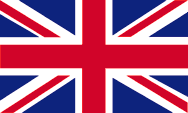

• Niederländische Ostindien-Kompanie
• Niederländische Westindien-Kompanie
• Britische Ostindien-Kompanie
• Französische Ostindien-Kompanie
• Britische Südafrika-Gesellschaft
• Königliche Niger Compagnie
• Deutsche Neuguinea-Kompagnie
• Deutsch-Ostafrikanische Gesellschaft (DOAG)
• Jaluit-Gesellschaft
• Nordwest Kompanie
• Hudson Bay Kompanie
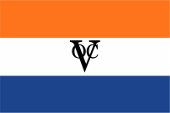
1602–1660,
Flagge der Niederländischen Ostindien-Kompanie,
Quelle, nach: commons.wikimedia.org



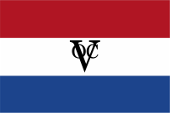
1660–1798,
Flagge der Niederländischen Ostindien-Kompanie,
Quelle, nach: commons.wikimedia.org



Geschichte:
Die Niederländische Ostindien-Kompanie (niederländisch Vereenigde Oostindische Compagnie; Vereenigde Geoctroyeerde Oostindische Compagnie, abgekürzt VOC) wurde am 20.03.1602 gegründet und wurde zu einem der bedeutendsten Handelsunternehmen im 17. und 18. Jahrhundert. Der niederländische Staat verlieh ihr Hoheitsrechte zum Krieg, Bau von Befestigungen, Erwerb von Land und auch Handelsmonopole. Die Niederländische Ostindien-Kompanie erwarb und betrieb zahleiche Stützpunkte in Asien, z.B.: Batavia (Jakarta) im heutigen Indonesien, Deshima (Japan), Persien, Chinsura in Bengalen im heutigen Bangladesch und Indien, Ceylon (Sri Lanka), Formosa (Taiwan), Kapstadt im heutigen Südafrika und Cochin im Süden des heutigen Indien. Nach Niederlagen im Vierten Englisch-Niederländischen Krieg (1780-1784) verlor die Gesellschaft an Bedeutung und wurde 1798 aufgelöst. Die Flagge der Niederländischen Ostindien-Kompanie zeigte jeweils die Farben der Niederlande, im mittleren weißen Streifen ergänzt um das Logo der Gesellschaft, gebildet aus den Anfangsbuchstaben des offiziellen niederländischen Namens: VOC
Quelle, nach: Wikipedia (DE)

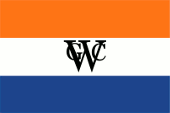
1621–1660,
Flagge der Niederländischen Westindien-Kompanie,
Quelle, nach: commons.wikimedia.org



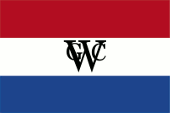
1660–1791,
Flagge der Niederländischen Westindien-Kompanie,
Quelle, nach: commons.wikimedia.org



Geschichte:
Die Niederländische Westindien-Kompanie (niederländisch Geoctroyeerde West-Indische Compagnie, WIC) wurde am 03.06.1621 gegründet und wurde zu einem der bedeutendsten Handelsunternehmen im 17. und 18. Jahrhundert. Der niederländische Staat verlieh ihr ein exklusives Handelspatent (Handelsmonopol) für den Handel in Westafrika und Amerika. Die Niederländische Westindien-Kompanie erwarb und unterhielt zahleiche Stützpunkte in Afrika und Amerika, z.B.: Neu-Niederland, Niederländisch-Guayana, Niederländisch-Brasilien und einige befestigte Handelsstützpunkte an der Goldküste. Schwerpunkt der Gesellschaft war der Sklavenhandel. Im Jahre 1661 ging Niederländisch-Brasilien nach 30 Jahren Krieg verloren, 1674 auch Neu-Niederland. 1717 und 1720 verkaufte Friedrich Wilhelm I., König von Preußen, seine afrikanischen Besitzungen an die Gesellschaft. 1734 wurde das Handelsmonopol abgeschafft, es kam zu finanziellen Problemen, und die Gesellschaft wurde 1791 aufgelöst. Die Flagge der Niederländischen Westindien-Kompanie zeigte jeweils die Farben der Niederlande, im mitteleren weißen Streifen ergänzt um das Logo der Gesellschaft, gebildet aus den Anfangsbuchstaben des offiziellen niederländischen Namens: GWC
Quelle, nach: Wikipedia (DE)

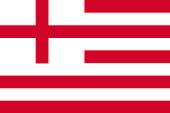
ca. 1615–1707,
Flagge der Englischen Ostindien-Kompanie,
Quelle, nach: commons.wikimedia.org



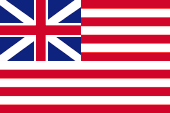
1707–1801,
Flagge der Britischen Ostindien-Kompanie,
Quelle, nach: commons.wikimedia.org



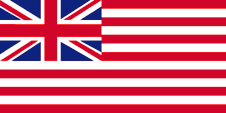
1801–1874,
Flagge der Britischen Ostindien-Kompanie,
Quelle, nach: commons.wikimedia.org



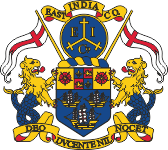
1600–1698,
Wappen der Englischen Ostindien-Kompanie,
Quelle, nach: Wikipedia (EN)
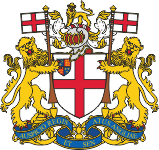
1698–1874,
Wappen der Englischen (Britischen) Ostindien-Kompanie,
Quelle, nach: commons.wikimedia.org
Geschichte:
Die Britische Ostindien-Kompanie (British East India Company, BEIC), bis 1707 English East India Company (EIC) genannt, wurde am 31.12.1600 gegründet und wurde zu einem der bedeutendsten Handelsunternehmen. Der englische (britische) Staat verlieh ihr ein exklusives Handelspatent (Handelsmonopol) für den Handel zwischen dem Kap der Guten Hoffnung und der Magellanstraße. 1661 wurden der Kompagnie von der englischen Krone umfangreiche Hoheitsrechte wie Zivilgerichtsbarkeit und Militärgewalt zugestanden, wenig später kamen noch der Festungsbau, Rekrutierungsrecht und Münzrecht dazu. In Indien wurden ständige Niederlassungen gegründet, 1612 in Surat, 1639 in Madras, 1668 in Bombay, später auch umfangreicher Grundbesitz erworben, so Bengalen und Binar und an der Ost- und Westküste. 1813 wurden die Handelsprivilegien abgeschafft, und 1858 die Hoheitsrechte in Indien an Großbritannien abgetreten. Im Jahre 1874 wurde die Kompagnie aufgelöst. Die Flagge der Britischen Ostindien-Kompanie ging aus jener der Englischen Ostindien-Kompanie hervor. Die Anzahl der Streifen wurde erhöht und die Flagge Englands in der Oberecke ersetzt durch diejenige von Großbritannien. Manchmal wird gemutmaßt, die Flagge der Britischen Ostindien-Kompanie sei das Vorbild für die Fahne der USA gewesen.
Quelle, nach: Wikipedia (DE)

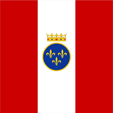
1664(?)–1794(?),
Flagge der Französischen Ostindienkompanie,
Quelle: Picaballo, CC BY-SA 3.0, via Wikimedia Commons



Geschichte:
Die Französische Ostindienkompanie bestand von 1664 bis 1719. Sie betrieb Handel mit Gewürzen, Tee, Kaffee, Arzneimitteln, Tuchen, Porzellan und Seide und unterhielt Faktoreien und Kolonien an den Küsten von Afrika, Madagaskar auf Réunion, an der Küste der Arabischen Halbinsel, auf Inseln in Südostasien, in China und Japan, in Haiti und Louisiana und an der Küste von Indien (z.B. Pondicherry und Chandernagor). Im Jahre 1719 wurden alle Französischen Handelskompanien (Mississippi-Kompanie, Französische Westindienkompanie, Französische Chinakompanie usw.) zur Französischen Indienkompanie (Compagnie des Indes) fusioniert, wurde 1769 vom König von Frankreich übernommen und aufgelöst, wurde 1785 erneut gegründet und ging 1794 bankrott.
Quelle, nach: Wikipedia (EN)

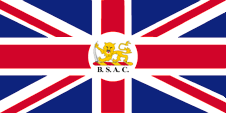
1892–1924,
Flagge der Britischen Südafrika-Gesellschaft,
Quelle, nach: Wikipedia (EN)



Geschichte:
Die Britische Südafrika-Gesellschaft (British South Africa Company, BSAC oder BSACO) wurde 1889 von Cecil Rhodes und Alfred Beit in London gegründet, wo die Gesellschaft auch ihren Sitz hatte. Ihre Tätigkeit war die koloniale Erschließung und Verwaltung des südlichen Afrika. So verkaufte die Gesellschaft vor allem in Rhodesien (Sambia und Simbabwe) Schürfrechte. Der britische Staat verlieh ihr 1889 mit einen Schutzbrief (Royal Charter) umfangreiche Hoheitsrechte in der Verwaltung von Matabele-, Maschona- und Manikaland, lediglich die auswärtigen Beziehungen waren Großbritannien vorbehalten; ab 1899 kam noch Nordwest-Rhodesien (Barotseland), und ab 1900 auch noch Nordost-Rhodesien dazu. 1924 wurden der BSAC von Großbritannien ihre Hoheitsrechte in Nordrhodesien entzogen und das Land der Verwaltung durch einen Gouverneur unterstellt. Im Jahr 1964 übergab das Unternehmen seine Mineralrechte an die Regierung von Sambia, und 1965 wurde die BSAC mit anderen Gesellschaften zur "Charter Consolidated Ltd." vereinigt, die 1993 in "Charter plc" umbenannt wurde. Die Flagge der Britischen Südafrika-Gesellschaft zeigte das Bild der Flagge von Großbritannien, jedoch in der Mitte - auf einer weißen Scheibe - um das Logo der Gesellschaft ergänzt.
Quelle, nach: Wikipedia (DE)

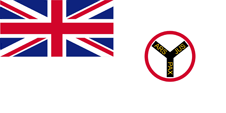
1879–1929,
Flagge der Königlichen Niger Compagnie,
Quelle, nach: Wikipedia (EN)



Geschichte:
Die Royal Niger Company wurde 1879 als United African Company gegründet und wurde 1888 mit einem königlichen Schutzbrief ausgestattet und in Royal Niger Company (RNC) umbenannt. Ihre Aufgabe war die wirtschaftliche Erschließung des Gebietes des heutigen Nigeria. Allerdings musste sie 1899 alle Ländereien, Besitzrechte und Hoheitsrechte an die Britische Regierung abtreten. 1929 wurde die RNC Teil der United Africa Company, die in den 1930er Jahren von Unilever übernommen wurde und existierte noch bis 1987.
Quelle, nach: Wikipedia (EN)

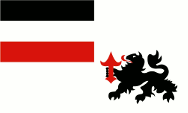
1885–1914,
Flagge der Deutschen Neuguinea-Kompagnie,
Quelle: Jolle [GFDL oder CC-BY-SA-3.0], via Wikimedia Commons



Geschichte:
Die Neuguinea-Kompagnie wurde 1882 in Berlin gegründet, wo die Gesellschaft auch ihren Sitz hatte. Ihre Tätigkeit war die koloniale Erschließung und Verwaltung von Kolonialbesitz in der Südsee (Neuguinea, Bismarck-Archipel und Salomonen). Der deutsche Staat verlieh 1885 mit einen Schutzbrief umfangreiche Hoheitsrechte zur Erschließung und Verwaltung des Nordostens von Neuguinea (Kaiser-Wilhelms-Land und Bismarck-Archipel); 1886 kamen noch die Nord-Salomonen dazu, lediglich die auswärtigen Beziehungen waren dem Deutschen Reich vorbehalten. Die höchste Autorität der Gesellschaft war der Landeshauptmann. Die Neuguinea-Kompagnie kam in finanzielle Schwierigreiten, so dass das Deutsche Reich sich gezwungen sah die Hoheitsrechte zurückzukaufen, so dass ab 1899 nicht mehr ein Landeshauptmann regierte, sondern ein kaiserlicher Gouverneur. Die Gesellschaft verlor alle ihre Besitzungen im Zuge der Enteigung und Vertreibung der Deutschen aus Neuguinea wärend und nach dem Ersten Weltkrieg. Die Flagge der Neuguinea-Kompagnie zeigte ein weißes Grundtuch, und in der Oberecke die damalige Flagge des Deutschen Reiches, sowie im fliegenden Ende einen schreitenden schwarzen Löwen.
Quelle, nach: Wikipedia (DE)

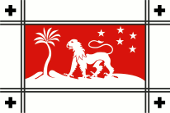
1885–1895,
Flagge der Deutsch-Ostafrikanischen Gesellschaft (DOAG),
Quelle, nach: Flags of the World



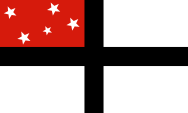
1895–1920,
Flagge der Deutsch-Ostafrikanischen Gesellschaft (DOAG),
Quelle, nach: Flags of the World



Geschichte:
Im Jahre 1884 wurde Gesellschaft für deutsche Kolonisation (GfdK) von Graf Behr-Bandelin und Carl Peters in Berlin gegründet. Carl Peters reiste zusammen mit Joachim Graf von Pfeil, Karl Ludwig Jühlke und August Otto nach Ostafrika und besuchten das Hinterland der der Insel Sansibar gegenüberliegenden Besitzungen des Sultans von Sansibar, und erwarben bei örtlichen Häuptlingen in den Regionen Usegua, Nguru, Usagara und Ukami Schutzverträge, für die sie bei der kaiserlichen Regierung einen mit Hoheitsrechten verbundenen Schutzbrief ausstellen ließen. Nach Ausstellung des Schutzbriefes gründete Carl Peters am 02.02.1885 die Deutsch-Ostafrikanische Gesellschaft. Ihr Tätigkeitsfeld war die koloniale Erschließung und Verwaltung Ostafrikas. Nachdem es 1888 zu Aufständen der Sansibarer Küstenbewohner gekommen war, übernahm das Deutsche Reich 1890 alle Hoheitsrechte in Deutsch-Ostafrika. Die Gesellschaft verlor alle ihre Besitzungen im Zuge der Enteignung und Vertreibung der Deutschen aus Deutsch-Ostafrika wärend und nach dem Ersten Weltkrieg. Die 1885 geschaffene Flagge war weiß mit einem roten Mittelfeld, das durch schwarze, jedoch bis zum Rand der Flagge reichende Doppellinien vom weißen Rand getrennt war. Im roten Mittelfeld erschien in Weiß eine stilisierte Landschaft mit einem Löwen, einer Palme und den fünf Sternen des Kreuzes des Südens. Die Ecken der Flagge zeigten vier schwarze gemeine, griechische Kreuze mit gleich langen Balken. Im Jahre 1895 wurde eine neue Flagge für die Gesellschaft eingeführt. Sie wird Carl-Peters-Flagge oder Petersflagge genannt, nach Carl Peters, dem Gründer von Deutsch-Ostafrika. Diese Flagge war weiß mit einem durchgehenden schwarzen Balkenkreuz und einer roten Oberecke, die mittels fünf weißer Sterne das Sternbild des "Kreuz des Südens" anzeigte.
Quelle, nach: Wikipedia (DE)


1887,
Flagge der Jaluit-Gesellschaft,
Quelle, nach: Wikipedia (DE)



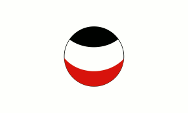
1888–1914,
Flagge der Jaluit-Gesellschaft,
Quelle, nach: Wikipedia (DE)



Geschichte:
Die Jaluit-Gesellschaft wurde im Jahre 1887 gegründet. Ihr Tätigkeitsfeld war die koloniale Erschließung und Verwaltung in der Südsee (Marshallinseln, Gilbertinseln und Karolinen). An Grundeigentum erwarb die Gesellschaft die Atolle Jaluit, Bigar, Ujelang und Kili. Die Hauptfaktorei befand sich auf der Insel Jabor im Jaluit Atoll. Der deutsche Staat verlieh 1888 mit einen Schutzbrief umfangreiche Hoheitsrechte zur Erschließung und Verwaltung der Marshallinseln, lediglich die auswärtigen Beziehungen waren dem Deutschen Reich vorbehalten. Das Deutsche Reich kündigte den Schutzbrief im Jahre 1906 und übergab die Inseln als Bezirk Jap an die Kolonie Deutsch-Neuguinea. Die Gesellschaft verlor alle ihre Besitzungen im Zuge der Enteigung und Vertreibung der Deutschen aus Deutsch-Neuguinea wärend und nach dem Ersten Weltkrieg. Die Flagge der Jaluit-Gesellschaft war zunächst einfarbig rot mit den Initialen der Gesellschaft in weiß. Ab 1888 zeigte die Flagge der Gesellschaft die Farben des Deutschen Reiches auf einer Scheibe in der Mitte einer einfarbig weißen Flagge.
Quelle, nach: Wikipedia (DE)

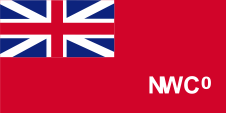
1783–1801,
Flagge der Nordwest Kompanie,
Quelle, nach: Wikipedia (EN)



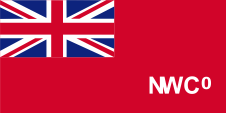
1801–1821,
Flagge der Nordwest Kompanie,
Quelle, nach: Wikipedia (EN)



Geschichte:
Die North West Company (NWC) wurde 1783 als Handelskompanie für Pelze und als Konkurrenz zur Hudson’s Bay Company (HBC) gegründet, die sich außerhalb des Einzugsgebietes der Hudson Bay in nordwestlicher und westlicher Richtung von den Großen Seen aus im heutigen Kanada ausbreitete. Die Konkurrenz zur HBC war so hart, dass es zu Beginn des 19. Jahrhunderts sogar zu bewaffneten Auseinandersetzungen zwischen beiden Kompanien kam. Die britische Regierung beendete den Konflikt, in dem sie 1821 die Auflösung der NWC und Vereinigung mit der HBC erzwang.
Quelle, nach: Wikipedia (DE)


1682–1707,
Flagge der Hudson Bay Kompanie,
Quelle, nach:
Wikipedia (EN),
canadashistory.ca



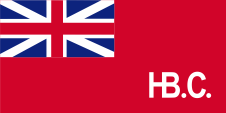
1707–1801,
Flagge der Hudson Bay Kompanie,
Quelle, nach:
Wikipedia (EN),
canadashistory.ca



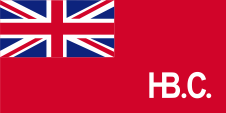
1801–1965,
Flagge der Hudson Bay Kompanie,
Quelle, nach:
Wikipedia (EN),
canadashistory.ca




seit 2013,
Flagge der Hudson Bay Kompanie,
Quelle, nach: Wikipedia (EN),
hbcheritage.ca,
Unknown authorUnknown author,
Public domain, via Wikimedia Commons



Geschichte:
Die Hudson’s Bay Company (HBC) wurde 1670 als Handelskompanie für Pelze gegründet, für den Bereich des Einzugsgebietes der Hudson Bay gegründet. Der englische (britische) Staat verlieh ihr ein exklusives Handelspatent (Handelsmonopol) und der Kompagnie wurden umfangreiche Hoheitsrechte zugestanden. Die Konkurrenz zur 1783 gegründeten North West Company (NWC) wurde so hart, dass es zu Beginn des 19. Jahrhunderts sogar zu bewaffneten Auseinandersetzungen zwischen beiden Kompanien kam. Die britische Regierung beendete den Konflikt, in dem sie 1821 die Auflösung der NWC und Vereinigung mit der HBC erzwang. Im Jahre 1867 wurde die Konföderation Kanada (Dominion of Canada) gebildet, und 1869 musste die Hudson's Bay Company (HBC) überträgt alle ihre territorialen und Hoheitsrechte Kanada abtreten und 1870 aller Territorialbesitz an Kanada verkauft. Die Kompanie formierte sich als Warenhauskette um und existiert bis heute. Mit der Einführung der Ahornblattflagge für Kanada im Jahre 1965 wurde auch für die Flagge der HBC das Red-Ensign-Erscheinungsbild fallen gelassen.
Quelle, nach: Wikipedia (DE)


![]()

























